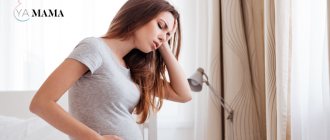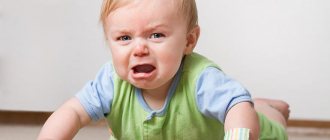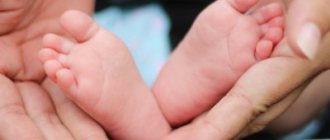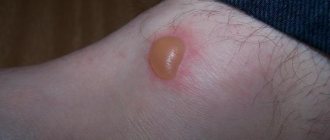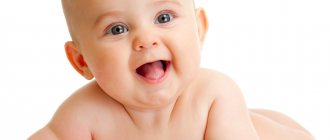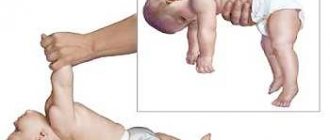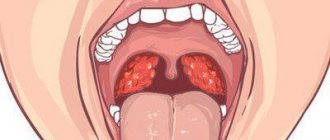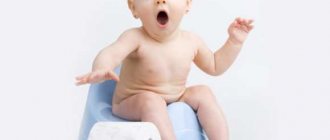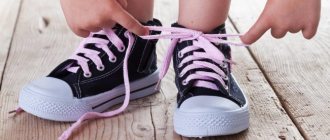The musculoskeletal or musculoskeletal system is understood as a set of bones, joints, ligaments and muscles, thanks to the coordinated work of which a person controls the position of the body in space.
The orthopedist makes the first conclusions about the correct formation of the skeleton in a newborn while still in the maternity hospital. Congenital anomalies and malformations can be seen by the position of the baby's head and the symmetry of the folds in his arms and legs. Timely diagnosis of pathologies makes it possible to correct many diseases with the help of massage, exercise therapy and physiotherapy. However, even a completely healthy child is not protected from the development of musculoskeletal diseases in the future. The high risk of disorders is associated with the characteristics of children's physiology and anatomy.
At preschool age, the child’s skeleton consists mainly of cartilage tissue; it is more susceptible to external influences than that of an adult. This is necessary for further growth and the formation of a strong body. But frequent forced stress during prolonged standing, sitting in an uncomfortable position, or carrying heavy loads can change the shape of the feet or spine and lead to flat feet, scoliosis and other deformities.
Additional development of pathologies is created due to the uneven development of the muscle corset. The deep back muscles, which support the correct position of the spinal column, are not yet strong enough at 6-7 years of age. Because of this, the child slouches and incorrect body position becomes habitual.
A high load on the musculoskeletal system is created during puberty: at 11-14 years. Under the influence of hormones, the skeleton changes rapidly: bones lengthen, but muscle mass grows much more slowly. As a result, there is a risk of lordosis, kyphosis and other pathologies.
Since the human skeleton is formed and constantly changes from the moment of birth until he reaches the age of 17-22 years, in order to monitor the correct development of the musculoskeletal system, it is necessary to regularly visit a pediatric orthopedist. A preventive examination allows you to identify deformations in the initial stages and correct them in time.
Other causes of the development of diseases of the musculoskeletal system in children include:
- excess body weight;
- sedentary lifestyle;
- severe chronic diseases (for example, diabetes).
What does a pediatric orthopedist do?
A pediatric orthopedist diagnoses and treats pathologies of the musculoskeletal system of various etiologies, and also deals with their prevention. The doctor observes children from birth to 18 years of age.
The newborn undergoes the first orthopedic examination in the maternity hospital, then it is recommended to visit a specialist regularly during the following periods:
- when the child reaches 1 month;
- at 3 months;
- at 6 months;
- in year.
Then it is advisable to bring the child to the orthopedics department at 3 years, 6 and 9 years. Regular examinations allow a pediatric orthopedist to monitor the formation of the child’s skeleton and muscle corset, which reduces the risk of developing acquired disorders: scoliosis, flat feet, osteochondrosis and others. It is especially important to consult with a specialist during periods of active growth and increased physical activity: for example, before entering first grade (6-7 years) and during puberty (11-13 years).
It is necessary to make an unscheduled appointment with a pediatric orthopedist if you notice the following symptoms:
- asymmetrical arrangement of skin folds on the arms and hips in children under 1 year of age;
- delay in physical development: the child turns over late and with difficulty, sits down, does not begin to walk;
- limited movement in the hip joint: it is easy to notice during swaddling or changing clothes that the child’s legs “do not open”;
- unequal length of upper or lower limbs.
For children aged 3 years and older, signs of dysfunction of the musculoskeletal system are:
- heavy, uneven gait: the child has difficulty standing on his feet, constantly grabs support (wall, chair);
- clubfoot: incorrect position of the feet during movement;
- noticeable stoop or “sidewaysness” both when walking and when sitting;
- visible changes in the joint area: swelling, swelling, redness of the skin, appearance of a rash, cyanosis of the integument;
- child complaints of muscle or joint pain;
- physical weakness: may manifest itself in poor coordination during outdoor games, the child “falls out of his hands”;
- forced head position;
- numbness of the limbs or unusual sensations in the arms and legs (tingling, goosebumps);
- local increase in body temperature;
- Injuries suffered: severe bruises, dislocations, fractures, torn ligaments.
Often, problems with the musculoskeletal system are indicated by indirect signs: for example, hearing or vision impairment may develop due to the curvature of the spine. If a child is actively involved in contact sports (football, basketball, hockey), athletics, this increases the risk of damage to ligaments and joints and increases the load on the skeleton. In this case, parents are recommended to bring their child for examination to a pediatric orthopedist at least once a year.
Medical editorial studio MedCorr
The next scheduled examination by an orthopedist is carried out at 3 months. Symptoms of diseases become clearer, and signs of acquired pathologies can be identified. All subsequent examinations follow the same plan as per month. Let us emphasize the features for a three-month-old baby. Deformation of the bones of the skull, namely flattening of the occipital bone, softness and pliability of the bones in the area of the fontanelle and sutures, as well as a bald patch on the back of the head can occur during the active phase of rickets, the head is asymmetrical. With post-traumatic torticollis, as a result of damage to the sternoclavicular muscle and the formation of a scar, or with an improperly healed clavicle fracture, signs of torticollis appear.
When lying on his back, the child should already be able to hold his head well, without the usual turning or bending. Some babies are already turning over from their back to their stomach. Parents need to ensure that rolls over the left and right shoulders occur with the same frequency. If there are chest deformities, they become more noticeable. With hip dysplasia, as a rule, there is a limitation in hip extension, but without confirmation by ultrasound, the diagnosis is not made - this may also be a symptom of increased tone.
During the examination, the doctor will also assess the dynamics of development, which is also important, and will give additional recommendations.
Next checkup at 6 months. The main goal is to test motor skills and identify signs of metabolic disorders - phosphate diabetes, rickets. Children are already actively turning over, trying to sit up, and the thoracic and vertebral curves of the spine begin to form. After examining the head, the doctor turns attention to the chest. With rickets, in the area where the bony part of the ribs transitions to the cartilaginous part, there are thickenings - rachitic rosaries. The chest is compressed from the sides, the sternum protrudes forward in the form of a boat keel. The spine curves posteriorly and kyphosis forms. Often with rickets, physiological curves intensify, but with severe degrees, new curves also appear. You cannot force a child to sit down, as this can lead to thoracolumbar kyphosis - a violation of posture like a round back. Hands and legs are assessed according to the plan. In conclusion, the doctor gives additional recommendations for care.
At 9 months , most babies are actively crawling; this is an excellent preparation for the musculoskeletal system for walking. They begin to stand at the support and take their first steps. This is a serious test for the baby's legs. The lower limbs experience heavy stress. They are given special attention during inspection. The legs can be in the shape of the letter O or X. This happens when muscles and ligaments are weak, or when bones are deformed. For example, with rickets, the legs are strongly O-shaped. An X-shaped curvature is less common. If necessary, the doctor will prescribe treatment and help you choose shoes for the correct formation of the foot.
Check-up at 12 months - summing up the most change-rich year in life. The child actively walks through life - by the hand or on his own. Particular attention is paid to the gait, although it is still, as a rule, uncertain, the baby spreads his legs widely, leaning more on the outer edge of the foot, turns his toes inward, and the knee joints are slightly bent. After a year, the alignment of the lower limbs may change to an X-shape due to the vertical load. After the examination, the doctor will give recommendations on further motor regimen, because despite the fact that the most active first year has passed, the formation of the musculoskeletal system is not complete.
Examinations in the maternity hospital at the ages of 1, 3, 6, 9, 12 months are routine, but if the child has abnormalities, the doctor prescribes additional appointments to assess the dynamics and effectiveness of treatment. Please don't miss them. And if suddenly you have doubts about the health of your child or the baby is injured, do not self-medicate, consult a specialist. After all, human health is formed from childhood. The child’s skeleton is very plastic; with timely detection of pathology, joint efforts of the doctor and parents, and compliance with all prescriptions, disorders of the musculoskeletal system can be corrected.
Natalya Zueva, pediatric orthopedist
Similar articles:
- Advice for parents: examination by an orthopedist. Part 2
- Advice for parents: examination by an orthopedist. Part 1
- The first year of a child’s life: why is medical examination needed?
- Your child is a preschooler. Why do you need an orthopedic examination?
- Family physical education: benefits for parents and children
Tags: pediatric orthopedist, children's health, original articles, disease prevention
What does a pediatric orthopedist treat?
A pediatric orthopedist treats a wide range of pathologies of the musculoskeletal system, both congenital and acquired.
Doctors are faced with the following congenital disorders in the development of the upper limbs:
- syndactyly – complete or partial fusion of the fingers due to a genetic abnormality. The disease is diagnosed directly in the maternity hospital, cannot be treated with medication and requires surgical intervention;
- polydactyly is a hereditary anomaly expressed in an increased number of fingers;
- Sprengel's disease or abnormal (high) shoulder position - characterized by the irregular shape of one of the shoulder blades: it becomes shorter and wider, which leads to a constant forced raised position of the shoulder;
- clubhanded - the hand is deviated from the ulna at an incorrect angle, which can be associated both with the pathology of the bones themselves and with the abnormal structure of the tendons.
A pediatric orthopedist also treats congenital anomalies of the lower extremities. One of the most common is hip dysplasia. The disease manifests itself in the form of complete or partial dislocation of the hip due to its improper intrauterine formation.
Congenital orthopedic pathologies are associated with impaired embryonic development of the fetus, which is influenced by poor genetics or severe illness of the mother during pregnancy. Birth injuries can lead to problems with the musculoskeletal system in an infant.
Other common diseases encountered by pediatric orthopedists include:
- Clubfoot is a deformation of the foot, as a result of which it deviates from the direction of the lower leg and is located at an incorrect angle to it. In this case, the patient’s heel turns inward or outward. The anomaly is congenital and responds quite well to treatment;
- Scoliosis is a curvature of the spine caused by structural bone defects, trauma or other reasons. Manifests itself in the form of stoop, asymmetrical arrangement of the shoulder blades and ribs, limited movement of the body;
- Osteochondrosis is a disorder of the structure of intervertebral discs, leading to their deformation and decreased functionality. The disease affects various parts of the spine, depending on which its symptoms change. The patient complains of pain in the back, chest or neck, suffers from limited mobility;
- arthritis is an inflammation of the joints, most often of an infectious nature in childhood. The affected area becomes inflamed and painful, the joint loses mobility;
- torticollis is a disease characterized by a forced tilted position of the patient’s head. Occurs due to shortened neck muscles or a deformed skeleton;
- flat feet – deformation of the foot with a drooping arch. The disease can be congenital or acquired and is divided into several degrees depending on the severity of the pathology.
The danger of any diseases of the musculoskeletal system lies in the fact that improper formation of the skeleton leads to disruption of the location of internal organs relative to each other, their compression and insufficient nutrition. When a child has flat feet, the load on the knee and hip joints increases, they become more vulnerable to injury and wear out faster.
In case of curvature of the spine, the volume of the thoracic and abdominal cavities decreases, and the nutrition of the spinal cord and brain deteriorates. Associated symptoms develop: the child often experiences headaches, concentration and attentiveness deteriorate, and hearing and vision may decrease. Therefore, it is so important to diagnose and begin treatment of diseases of the musculoskeletal system in a timely manner.
Many diseases of the musculoskeletal system respond well to treatment at an early age. This is due to the peculiarity of the children's skeleton: it is more mobile and pliable. Therefore, regular performance of special exercises and strict adherence to the recommendations of the orthopedist allows you to completely get rid of the disorders or largely compensate for them.
Also, a pediatric orthopedist is often consulted for injuries: bone fractures, dislocations, ruptures of ligaments and tendons. Their symptoms:
- limited mobility of the injured limb (or joint). When you try to move, a sharp pain occurs;
- change in the color of the skin at the site of injury - the skin may turn red or blue, and a hematoma often forms;
- swelling and edema in the damaged area, possibly with a local increase in temperature.
If these symptoms are detected, you must call an ambulance.
Orthopedist for a baby
The author of the article is Natalya Gennadievna Rakova, a doctor of the highest category, orthopedic traumatologist at the Mother and Child clinic in Kuntsevo. Published in the magazine Rody.ru No. 2-2016.
Among the doctors who must see the baby in the first year of life will be an orthopedist - a doctor who monitors the condition of
a person’s musculoskeletal system, or, more simply, the condition of our muscles, bones and joints.
We will tell you why observation by this specialist is needed and what parents of infants should pay attention to. the earlier the better
It would seem, why show the baby to an orthopedist, because he still does not sit, does not stand up, does not walk. It turns out that there is no load on the bones and muscles, so it seems that there is nothing to see in the baby. Some parents think so and for some reason are in no hurry to show their child to an orthopedist. Other mothers and fathers do not go for consultation because they believe that their baby is developing normally. After all, he doesn’t have any noticeable changes: his arms and legs are in place, they seem to be the same length, his back is straight - that means everything is fine with the baby. In fact, some diseases of the musculoskeletal system are not always obvious and are usually not noticeable to parents.
And it is generally impossible to independently determine, for example, whether a baby’s legs are the same length without being a specialist. And even a pediatrician, if the pathology is not pronounced, may not detect it, especially if the disease does not bother the child. But as the baby grows, orthopedic problems may intensify and curing the disease will be much more difficult than at an early age. Therefore, the newborn should be shown to an orthopedist as early as possible.
what does the doctor look at?
An orthopedist should be visited when the child is 1 month old, and then several more times - at 3, 6 and 12 months. At the first consultation, the doctor will examine the baby very carefully, literally from head to toe, assess the size and shape of all parts of the body, also check how proportional and symmetrical they are in relation to each other, and look at how the arms and legs move. The orthopedist will carefully examine all joints for mobility; he will especially carefully examine the hip joints and be sure to check whether the baby’s legs are the same length.
But even if there was no orthopedic pathology at 1 month, the baby still needs to be regularly shown to the doctor. During repeated examinations, some diseases may be identified that did not manifest themselves during the first visit to the doctor.
possible problems
What are the most serious diseases that an orthopedist should exclude in children of the first year of life?
— Hip dysplasia and congenital hip dislocation – these diseases arise due to congenital underdevelopment of the hip joint. If the disease is not detected in time, it can progress quickly, one leg will be much shorter than the other and the gait will be seriously impaired. Pathology can be detected as early as 1–3 months.
— Congenital muscular torticollis - immediately after birth it becomes noticeable that the child’s head is constantly tilted to the side and to the side. Torticollis must be treated, otherwise the child will develop asymmetry of the face, facial skull, shoulders, and spine.
- Congenital clubfoot - the baby’s legs “clubfoot”, like those of a bear cub: if the newborn could stand up, he would rest on the outer surface of the foot. Without treatment, if a child begins to walk on such legs, the deformity of the damaged foot increases, the relationship of the bones is disrupted, gait and posture suffer, and difficulties arise with choosing shoes.
These three main diseases must be identified as early as possible (and they can be detected as early as 1–3 months), because the sooner you start treating them, the better the result will be.
distribute the load
But even if the child does not have orthopedic pathology, the doctor will still advise the parents what to do to ensure that the baby’s bones and muscles develop correctly. For example, even healthy children can often turn their head to one side. This is usually because they are attracted to the side of the crib that has a colorful toy or other interesting item. Often parents simply do not notice this, but the orthopedist will immediately pay attention to which direction the child most often tilts his head.
He will also quickly see how the child turns over - again in one direction or in both. All this may be a variant of the norm, but sometimes it indicates that the child has different muscle tone on the left and right. In this case, the orthopedist will recommend massage, swimming and special exercises with an emphasis on a specific muscle group. The doctor will tell you how to strengthen other muscle groups: for example, the abdomen, back - all this will help the baby in the future begin to sit, stand up and walk on time.
don't rush the baby
The child is growing and seems to be ready to sit. He should sit up on his own at 7 months, stand on his legs at 9, and take his first steps at 10–11, holding onto a support.
Until this age, doctors recommend not encouraging the baby to sit or stand (placing him in pillows is especially harmful). The baby's bones and muscles are not yet ready for new movements, and if the child's muscle corset does not have time to strengthen before he begins to sit up on his own, this can lead to curvature of the spine. If the time has come, and the baby has not yet mastered a new skill, the orthopedist will tell you how to stimulate the baby (massage and gymnastics will help here again).
we help with the first steps
When the child tries to take his first steps, the orthopedist will tell you what shoes to buy for the baby. It will help to evenly load the ankle joint, which means that the load will be distributed correctly on all other joints. Doctors usually advise learning to walk not barefoot or in socks or booties, but in boots or shoes: leather, with a hard heel, a small heel, lace-up or Velcro
. If the baby has any pathology of the foot or ankle, the orthopedist will select special shoes or orthopedic insoles.
Beautiful posture, strong bones, strong muscles, harmonious figure
–
this is what parents want for their baby.
And an orthopedist will help you achieve this; the main thing is
to get to him for a consultation on time.
Tags:
- Baby,
- child,
- traumatologist
Rakova Natalya Gennadievna Traumatologist-orthopedist Mother and Child Clinic Kuntsevo
- Find out more about the doctor
- Make an appointment
What does a pediatric orthopedist check?
An examination by a pediatric orthopedist is carried out in the presence of parents or guardians. In children under one year of age, the doctor examines:
- shape and position of the head. The child should rotate his head freely. If this does not happen, the orthopedist can diagnose the so-called “habitual head rotation,” which can subsequently lead to skull deformation;
- spine and chest. To assess the axis of the spinal column, the doctor places the child in various positions to detect spinal displacement;
- the size of the limbs and the symmetry of the folds on the arms and legs. If the number of folds is different or they are unevenly located, this may indicate a violation in the formation of the skeleton.
When examining a child older than 1 year, the procedure may change. The orthopedist checks muscle tone and joint mobility - children should not experience discomfort when moving. If the doctor identifies any deviations from the anatomical norm of development for a certain age, additional studies are prescribed.
In pediatric orthopedics, the following examinations are most effective:
- general urine and blood tests. Show the presence of inflammatory processes and infections that can cause diseases of the musculoskeletal system;
- radiography. Mainly used to detect injuries to bones and joints, but the procedure is also indicative of suspected osteoporosis, bone and cartilage tumors, necrosis;
- Ultrasound. Allows you to assess the condition and structure of ligaments, tendons, as well as the soft tissues surrounding them.
All prescribed procedures are painless and safe for the child’s body. Based on their results, the doctor diagnoses the disease, determines the causes and severity of the pathology, and selects effective treatment.
To restore the health of the musculoskeletal system, the following can be used:
- drug therapy – aimed at relieving pain, improving the nutrition of bone and cartilage cells;
- physiotherapy - locally affects the affected area (joint or ligament), accelerates tissue regeneration, reduces pain and swelling;
- therapeutic physical education (physical therapy) – allows you to correct skeletal disorders due to the formation of a strong muscle corset;
- minimally invasive surgeries - performed according to indications, do not affect healthy tissue, resulting in a significantly shorter recovery period.
After the patient recovers, the orthopedist selects appropriate prophylaxis. Good results can be achieved through regular moderate physical activity and taking vitamin complexes. It is important to choose sufficiently loose shoes for your child with a comfortable last - it will protect the feet from excessive stress. It is also important to balance your diet: excess weight increases the load on the skeleton and often causes various diseases of the musculoskeletal system.
Formation of a child's foot - an orthopedist answers questions
Number of views: 63,168
Questions regarding the proper development of a child’s foot are answered by an orthopedic traumatologist of the highest category of orthopedic, candidate of medical sciences Sergei Serdyuchenko.
Orthopedic provides a full range of consultative and diagnostic services in the field of traumatology and orthopedics at a high professional level. Here you can undergo an examination by a pediatric orthopedist, an adult orthopedic traumatologist, order computer diagnostics of the foot, ultrasound, and the production of individual orthopedic insoles. The center also has specially equipped rooms for applying immobilizing bandages and intra-articular administration of medications.
Great news for members of the MomExpert club - 20% DISCOUNT for club card holders.
Click here to find out how to get your discount:
Get a discount!
Question: Until what age does a child’s foot develop? What should parents pay attention to? What preventive measures are needed? What are the rules for choosing winter/demi-season/summer shoes for kids? Is there a difference? Is it necessary to buy shoes marked “ORTO” for your baby?
Answer: The main formation of the foot occurs until approximately 12 years of age. This is the period when you can try to actively influence the development of the foot. The child should be examined by an orthopedist at least once a year and adjustments to the regimen should be made if necessary. The word “orthopedic” does not guarantee that these will be good quality boots. Shoes should always be chosen according to size, not for height.
Question: The child is two years old. When he walks in shoes, it is noticeable that one leg is a little clubbed. Everything seems fine at home. I don't notice anything like that. Should we sound the alarm? We did an ultrasound of the hip joints at half a year. Everything was fine.
Answer: The child needs to be examined by an orthopedist. There is a diagnosis of congenital clubfoot - this is a pathology of the foot: it requires serious orthopedic treatment and plaster casting, in your case this is clearly not it. What mothers call clubfoot is no such medical term: there is no Russian-language definition. There is an excessive rotation of the upper thigh in front, in this case the child artificially twists the leg inward. You can’t sit in a W shape, you need herringbone walking exercises and dancing. With growth, such a turn can worsen if sitting incorrectly.
Ultrasound of the hip joints cannot give a 100% picture of all variations in the formation of a child’s leg; it assesses the degree of development of the acetabulum. There is also the orientation of the upper thigh; as the child grows, it may not change for the better; nothing may appear right away; then children walk with their toes inward, sitting in a W shape. If something bothers you, it is better to see an orthopedist and look at the baby’s legs.
Question: My daughter is now 1 year and 2 months old. I myself have flat feet and hip dysplasia. At 4 months old, the child had an ultrasound of the hip joints and was told that everything was normal, there were ossification nuclei. She began to walk without assistance at 10 months. The question is: Does she need shoes at home or can she wear socks?
Answer: At home, shoes are desirable. You don’t have to wear it 24 hours a day, you can take it off and walk barefoot, on carpets, orthopedic rugs, etc. and don’t forget about muscle training.
Question: The child is 1.4. She has been walking independently since she was 11 months old. One leg bends inward. Especially noticeable in shoes on the street. At home, when without shoes, he walks on his toes, more often when he runs. When he is not in a hurry, he places his foot correctly, is this normal? Do I need to wear shoes at home? At what age can you walk on orthopedic mats and for how long and is it even necessary?
Answer: The child needs to be examined; sometimes it is necessary to conduct additional studies regarding the hip joints.
Question: Interested in when you should buy your child shoes for going outside (boots, boots)? When did you just switch to a stroller? Or when he starts walking on his own and walks next to the stroller, and before that, booties will suffice? Please tell me what the nose should be like in the first shoe? How to choose a size? And what is the maximum size reserve you can take in baby shoes? At what approximate speed does the leg grow in children of the first and second year?
Answer: Shoes are needed from the moment the child begins to stand up on his own. It is worth taking shoes by size, the margin is 5-7 mm, which toe of the shoe is not very important, pay attention to the heel, instep and sole.
Question: At 3 months old, the child was diagnosed with hip dysplasia. The folds were not symmetrical. They prescribed massage and paraffin. We completed the course. Further residual dysplasia at 1 year. We are now 2 years old. What are our actions? Should I take another photo and ultrasound? How can you see dysplasia yourself and what can be the risk of untreated dysplasia?
Answer: Dysplasia must be observed. As a rule, residual dysplasia does not threaten anything; everything will develop with growth. But in order to understand in which direction the process is going dynamically, you need to take pictures and compare them with earlier ones.
Question: Is it normal for a baby not to kneel at 6 months of age? Thank you in advance!
Answer: What a child begins to do is largely individual. I think it’s not scary that he doesn’t kneel.
Question: How do you know when your child is ready to sit up and learn to walk?
Answer: Do not put your child in a walker yourself. Your task is to work with his muscular system. When the muscles gain sufficient strength, the child will sit, crawl and walk.
Question: Please tell me, if at the three-month appointment with the orthopedist there were no questions, when is the next appointment. And is there any schedule for visiting this specialist?
Answer: During the first year of life it is worth showing up 2-3 times. If you were at 3 months, the next examination is at 6 months, and then at the discretion of the orthopedist.
Question: The child is almost 8 months old, sits unsteadily, and tries to crawl. He sits down over his hip, leaving one leg bent behind him and aligning the other, adjusting it all the time. Is such a landing scary? Another concern is the position of the feet: the toes are constantly stretched out and the feet are turned out, looking at each other (like a ballerina), and when in a vertical position, touching the plane, the feet are also on the toes, and the toes on one foot are turned. I saw a neurologist and an orthopedist two months ago, there were no questions. But I’m worried about what to do under such circumstances, should I worry?
Answer: Judging by the way you describe the situation, there is still hypertonicity and muscle imbalance. You need to work with a massage therapist to bring the muscles back to normal. Also sign up for a swimming pool with your child, this is very useful for his development.
Question: My daughter had a congenital dislocation of one hip joint and dysplasia of the second! We wore the Orlette splint for up to 9 months, then for another 3 months we wore a splint with rings! In a year everything was removed, the orthopedist said everything was fine. Now my daughter is 8 years old and sometimes complains of pain in her joints. What do we need to do, are there any residual problems?
Answer: Congenital dislocation is a fairly serious condition. As the child grows, it is necessary to monitor and monitor how the joints develop. First, you should see an orthopedist.
Question: My 2.5-year-old daughter began to roll her foot inward. We wear orthopedic shoes. What else can you do?
Answer: You need to look at it individually; if the valgus is severe, shoes may not be enough, then you need to raise the question of orthotics (orthopedic insoles). And train the inner calf muscle group.
Question: Please tell me, the child is already 1.10 and his right leg is clubbed. Is this possible and how can I fix it? (maybe massage or procedures) my husband is also clubbing, apparently it was inherited.
Answer: First, the child must be examined by an orthopedist and decide on the need for additional diagnostics. In addition, when he grows up, give him lessons in choreography, dancing, etc. to form the correct walking stereotype.
Question: A baby (7 months old) twists his leg when walking. Places it on the outside of the foot. We put on shoes when we want to stomp. Doesn't wear on a rug. He stomps around the house for maybe 5 minutes. Then a break. Then stomp again. Maybe the shoes need to be worn longer? Or is that enough?
Answer: There may be hypertonicity of the internal muscle group. A consultation with a neurologist, massage, and exercise therapy for the feet are required.
Question: at what age can a child sleep on a pillow, of course not a huge one, but a tiny one?
Answer: After a year you can use it.
Question: During childbirth, the child had a fractured collarbone. The orthopedist looked at it for a month and said it was normal. Is it worth observing and being interested in every orthopedic appointment?
Answer: A child’s collarbone grows together in a week without consequences, forget it.
Question: Your opinion on the first shoes for babies as soon as they stand on their feet and take steps along the support: it is necessary/not necessary. There are a lot of opinions. Also about ortho mats? If you need shoes, what brands? The choice now is from Nemansky to minimen)
Answer: In my opinion, in apartment conditions it is necessary. Ortho mats are needed, they make the muscles work. From the preventive: Whoopi, Miniman, Toto, Bartek, they are about the same class. But each manufacturer may have worse and better models. So you need to look at the specific manufacturer.
Question: The child is three months old. Is it possible to walk with my daughter for a short time in an ergo backpack? Or is it still impossible?
Answer: You can carry it in an ergo backpack for a short time: several times a day, up to 2-3 hours a day. Shouldn't be worn all day. Of all the carriers, a sling is the best.
Question: Walkers and jumpers - can a child wear them and for how long, from what age?
Answer: Jumpers and walkers are not recommended at all. Jumpers put stress on the spine, while walkers put stress on the feet and back. The child has not yet started doing something himself, which means his muscular system is not yet ready, there is no need to force things. If the baby is already walking and pushing a wheelbarrow or stroller in front of him, this is possible.
Question: The child is 1.10, has x-shaped legs. Can this be fixed? What shoes are better to wear, what toys are preferable (bicycle, balance bike, etc.)?
Answer: There is no need to correct anything yet; the final shape of the legs will be formed later. See orthopedists and do general strengthening exercises. Let him ride.
Question: Does the hardness and surface of an Ortho mat matter? What advice would you give your baby for his first steps? Are they useful for a 7-month-old baby who doesn’t walk yet, but just stands at a support?
Answer: Ortho mats with different surfaces, needles, pebbles, etc. then different muscle groups are worked out.
Massage mats are separate modules that are connected to each other like a puzzle. Due to the different texture and hardness of the surface, during classes on ORTO PUZZLE mats, all the necessary receptors in the child’s foot are stimulated, contributing to the formation of its physiological arches.
Question: Is it possible to use ortho mats of different hardness for babies under one year old? Is there any benefit/harm if the baby just stands and doesn’t walk?
Answer: Accustom it gradually. If you just started walking on shoes, just roll them with a jagged ball on the sole. When he grows up, you will move to the mat.
Question: The child is 11 years old. One leg is slightly clubbed when walking. At birth, no pathologies were detected; during routine examinations, the orthopedist did not find any abnormalities. In the “heels together, toes apart” position, the toes are spread almost 180 degrees. Is it possible to somehow correct it with exercises and wearing orthopedic shoes? Not only I notice, but also those around me.
Answer: This is most likely a gait stereotype - a habit. Of course, you need an orthopedist to take a look, and if there are no problems, you need to teach the child to walk, change the gait pattern: choreography, dancing.
Question: What is the probability of a child having dysplasia if the mother had dysplasia in childhood (plaster was applied). And in general, is there a hereditary connection with dysplasia? (The orthopedist at the first visit at 1 month did not reveal any abnormalities in the child, but I did not know that I had dysplasia). Is a repeat examination necessary taking this fact into account and should an ultrasound be done now?
Answer: Heredity plays an important role in dysplasia, but the presence of dysplasia in the mother in childhood does not necessarily entail the development of dysplasia in the child. The child should be observed, and if questions arise, immediately contact an orthopedist. The child should be examined by an orthopedist at least once a year, if there are questions - once every six months. At 3 months, an ultrasound must be done, even though visually everything is fine.
Question: How long does surgery take for polydectyly of the lower extremities?
Answer: Up to 2 hours, it all depends on the form of the pathology and the scope of the operation.
Question: We are 9 months old, trying to stand on our feet, but mostly on our toes, not on our entire foot. Do I need to wear shoes now and what kind? Or only when the child starts? What should be present?
Answer: First of all, you need to be examined by a neurologist; most often the problem is hypertonicity of the posterior muscle group. Need to work with massage therapists. If the baby continues to walk on his toes, you need to add a higher heel to the usual criteria for proper shoes to firmly fix the ankle so that the habit of walking this way does not form.
Question: Should a child under three months have professional treatment? massage (relaxing and toning)?
Answer: Massage is recommended from 2 months, according to older indications. The mother has her own set of exercises, and the massage therapist works with the muscles; 2-3 courses of massage per year, even for a healthy child, allow the baby to develop better.
Question: Please tell me, when the child had an ultrasound of the hip joint at two and a half months, the ossification nuclei were not formed. Do I need to do a repeat ultrasound? If yes, then when? And in general it’s not very scary, is it?
An ultrasound is needed at about 5-6 months of age. At 2.5 months - if only the ossification nuclei, then this may be a variant of the norm. The assessment is carried out in a complex manner: not only the ossification nuclei, but also the alpha and beta angles and other criteria. Based on the combination of several parameters, a conclusion is made about the maturity of the joints. You are now recommended to use wide swaddling, work with a massage therapist, exercises: bicycle (circular movements in the hip joints)
Question: Hello. A child 1.7 on one leg has one toe “hiding” behind the ones next to it. Why is this and is it dangerous? And he also has a clubfoot on his right leg. Should we sound the alarm? (I myself have also had the right leg since childhood)
Answer: If it does not interfere with the child’s wearing of shoes or does not rub them, there is no need to do anything. Such congenital features of the foot occur. With age, everything is modeled. Regarding clubfoot, you should consult an orthopedist; you need to understand this individually: there are different variants of clubfoot and different correction methods.
There is a diagnosis of congenital clubfoot - this is a pathology of the foot: it requires serious orthopedic treatment and plaster casting, but in your case this is clearly not the case. What mothers call clubfoot is no such medical term: there is no Russian-language definition. There is an excessive rotation of the upper thigh in front, in this case the child artificially twists the leg inward.
Question: How to correct x-shaped legs in a girl? Return 2.3 years.
Answer: Just watch for now. For a child of this age, this is the norm. The final shape of the legs is formed by 7-8 years. Monitor your child's weight; excess weight has a very bad effect on the shape of your legs in the future. General physical training is recommended: swimming, cycling.
Question: What is your opinion about orthopedic shoes: treatment or marketing?
Answer: If a child has a specific problem, a severe foot deformity, then it is impossible to correct the situation without orthopedic shoes. If the child is healthy and the foot is formed correctly, you can select preventive shoes. If the child is not specifically trained and the foot muscles are not trained, then there is little chance that a healthy foot will form without the right shoes.
Question: The child has mild valgus. Is it possible to jump on a trampoline?
Answer: Yes! Jump for fun.
Question: Both parents have flat feet. My father's is small, my mother's is more serious. Is it hereditary? How to avoid it? Is it true that simple flat feet cause scoliosis?
Answer: Heredity is one of the risk factors for flat feet; there is a hereditary predisposition. Avoid is not quite the right word. It is necessary to create conditions for the normal development of the foot: exercises, shoes, and, if necessary, an insole correctly selected by an orthopedic doctor. Training your muscles is even more important than just shoes. Not all children with scoliosis have problems with their feet and vice versa, there is no direct correlation, sometimes it happens at the same time, but not always
Question: When should you put on your first shoes? What are the requirements for it?
Answer: After the child begins to stand on his feet. Requirements for the first shoe: a tight heel, an instep support, a closed midsection and a flexible sole. A closed nose, by the way, is not a mandatory criterion.
Question: Is ultrasound of the hip joints a month required?
Answer: Per month, according to the orthopedist: movement restrictions, asymmetry. At 3 and 6 months, it is recommended to do an ultrasound for all children, since it is not always possible to determine all types of pathology with your hands.
Question: Wearing orthopedic shoes at home for the purpose of prevention. Your opinion?
Answer: It is advisable to wear proper shoes. There is NO need to chase the word orthopedic; the manufacturer can register the shoes in any way they want. The right shoes: a tight heel, arch support, a closed midsection and a flexible sole. Orthopedic insoles - according to indications. If there are carpets - less relevant. Part of the time in shoes, part of the time barefoot. It’s good to train the foot and develop muscles: walk on your toes, on your heels, on the outer edge, pick up small objects with your toes, lay a towel and rake with your toes. Massage mats have proven themselves well.
Question: Is it likely that valgus positioning of the legs (no flat feet) will be corrected after 6 years? There is no hereditary factor.
Answer: There is a possibility. But you need to put in a lot of effort: the main thing is muscle training, insoles according to indications depending on the motor activity and the child’s regime. If a child plays sports, insoles are a must.
Question: The baby is 1.5 months old. The birth was natural, without complications, the fetus was positioned in the head. We went to see an orthopedist. According to the preliminary result of the examination, hip dysplasia was indicated, but naturally an ultrasound was prescribed at 3 months. Is it necessary to wait 3 months, or can an ultrasound be done a little earlier, so that if something is wrong, then treatment can be started earlier? While we are doing a light massage of the legs, “frog”, “bicycle”, “figure eight” on the foot.
Answer: If the orthopedist did not immediately identify gross pathology, then you can wait up to 3 months, since up to 3 months the joint may be immature, this is normal. 3 months is the limit, after this age the joint must mature. At this age you need to do an ultrasound and determine
Question: What are the restrictions on sports for valgus placement?
Answer: Valgus: running, jumping, contact sports with caution. If the child likes it and nothing bothers him, he can be placed on insoles and he can study. It is important to select the correct load and combine it with orthopedic components: the right sports shoes; for an athlete, it is better to have individual insoles made specifically for him, taking into account the peculiarities of the formation of the foot.
Question: I often hear the opinion that a child who has learned to walk should wear shoes at home to properly form the arch of the foot. Is it so? And what kind of shoes can be considered “correct”?
Answer: It is advisable to wear shoes at home, and the correct ones. Don’t bother with the word orthopedic; the manufacturer can register the shoes any way they want. The right shoes: a tight heel, arch support, a closed midsection and a flexible sole. Orthopedic insoles - according to indications. If there are carpets - less relevant. Part of the time in shoes, part of the time barefoot. It’s good to train the foot and develop muscles: walk on your toes, on your heels, on the outer edge, pick up small objects with your toes, lay a towel and rake with your toes. Massage mats have proven themselves well.
Question: My baby is 4 months old and the folds on his legs at the back are not symmetrical. At 3 months we went to the orthopedist and had an ultrasound, everything was fine, they were the same. Could this be due to the fact that he is chubby?
Answer: If everything is fine on ultrasound and clinically everything is normal when examined by an orthopedist, then everything is fine. Folds are not the most important diagnostic sign, it happens sometimes, it has nothing to do with weight, it’s just individual characteristics
Question: Is it necessary to show the child to an orthopedist at 1 year of age (as a medical examination) if there were no pathologies at 1 month?
Answer: Definitely. At least once a year, the child should be examined by an orthopedist-traumatologist; the situation may change with growth
Was this information interesting and useful for you? Please share your opinion!
comments powered by HyperComments
What is the difference between a pediatric surgeon and an orthopedist?
When faced with diseases of the musculoskeletal system in a child, parents may not know whether to make an appointment with a surgeon or orthopedist. A pediatric surgeon diagnoses and treats musculoskeletal pathologies, but he also treats other diseases: for example, boils, carbuncles, purulent lesions of soft tissues. The doctor also eliminates congenital anomalies (for example, syndactyly).
You should contact a pediatric surgeon in the following cases:
- a child receiving various types of injuries;
- inflammation or swelling of the joint with discoloration of the skin or local increase in temperature;
- detection of tumors in joints;
- limited movement of arms and legs, sudden attacks of pain when trying to perform a certain movement.
The pediatric surgeon will conduct an examination, refer you for additional examinations and determine the cause of the unpleasant symptoms, after which an effective treatment will be selected. You should also make an appointment with a surgeon if your child has an old (healed) injury that has begun to bother you - hurt, interfere with normal movement.
But in most cases, parents are advised to make an appointment with a pediatric orthopedist for their child. If during diagnosis or therapy the doctor needs to consult a surgeon, he will refer the patient to the right specialist.

